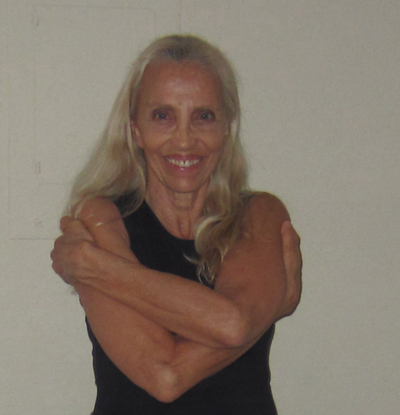7 Reasons For Workout Burnout- Then Do Tai Chi
7 REASONS FOR WORKOUT BURNOUT: THEN DO TAI CHI (ISSUE 125) April 15, 2014
By Diane Gold
How often do we get workout burnout and why do tai chi to avoid it or to fix it?
We are all about getting ourselves in shape, greedy to feel great and look spectacular. This is a good kind of greed because it keeps us healthy and our country flourishing. But, in my over 15 years of teaching martial arts (of which tai chi is one) and all my life watching people and their workouts, I have heard story after story about people’s workout history. There are only a few stories, even though we all, as individuals have our own.
 1. My Workout Is Boring.
1. My Workout Is Boring.
2. I Feel Empty And Disconnected From Myself When My Workout Is Over.
3. My Mind Is Not Relaxed After My Workout.
4. My Motivation Is Gone.
5. My Muscles Are So Tight From Working Out, I Move Like A Robot.
6. I Feel Totally Selfish When I I’m Finished.
7. I Want A Workout That Builds Me Spiritually.
These reasons may sound familiar. We can give ourselves reasons to quit or continue.
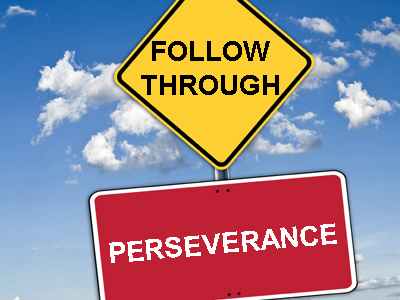 (1) If our activity doesn’t keep our attention, we quit. We usually are not taught the merits of follow through and perseverance, so we quit.
(1) If our activity doesn’t keep our attention, we quit. We usually are not taught the merits of follow through and perseverance, so we quit.
(2) If we don’t feel as if we have done something important, we quit. We usually don’t take the time to examine importance.
(3) If we are jittery and unrelaxed, we are forced to stop the behavior that’s causing it. We usually don’t know how to make the small adjustments needed to relax the situation.
(4) If we’re not motivated, we quit. Even if it’s one time, so often one missed session is enough to end the habit of working out.
(5) If our muscles are unnaturally tight, we may see it as counterproductive and quit. Most everyone has not been taught how to keep loose or to get loose.
(6) If we feel selfish, we may not like the feeling and we quit.
(7) If we see our workout as devoid of anything spiritual, we may feel plastic, unsubstantial and quit.
ENTER TAI CHI.
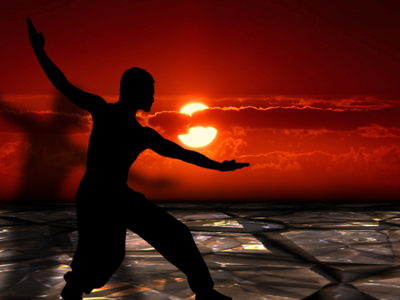 The art of tai chi is a system of movement that uses wave-like, circular patterns of moving the body, arms and legs. Its purpose is to connect everything that we do with the body with our mind and our spirit. It’s not a magic potion of movement; what it is is a very slow moving discipline that, because of its slowness, allows the mover to connect the movement to the mind. Its purpose is to teach the mind to act fluidly like the body movements. The physical moves are tools to connect us to ourselves.
The art of tai chi is a system of movement that uses wave-like, circular patterns of moving the body, arms and legs. Its purpose is to connect everything that we do with the body with our mind and our spirit. It’s not a magic potion of movement; what it is is a very slow moving discipline that, because of its slowness, allows the mover to connect the movement to the mind. Its purpose is to teach the mind to act fluidly like the body movements. The physical moves are tools to connect us to ourselves.
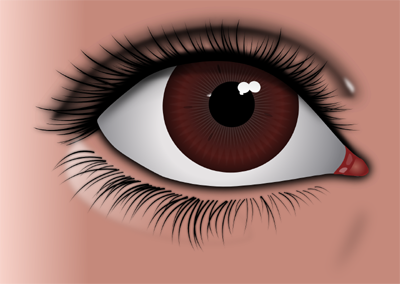 Here’s something to think about. When I am doing tai chi, the speed at which I am moving allows me to focus my attention on my movement. The movement allows me to focus on only 1 thing. This focus allows me to follow each body part, 1 at a time. I can, as well, connect my motion with the heat and the balance of my body, the expansion and compression of my lungs, the flow of my blood, and the space in which my body exists. I am in moving, martial meditation.
Here’s something to think about. When I am doing tai chi, the speed at which I am moving allows me to focus my attention on my movement. The movement allows me to focus on only 1 thing. This focus allows me to follow each body part, 1 at a time. I can, as well, connect my motion with the heat and the balance of my body, the expansion and compression of my lungs, the flow of my blood, and the space in which my body exists. I am in moving, martial meditation.
 Picture the adventure of a dandelion seed, using the fibers of the dandelion flower to keep it airborn, and it is whisked away by a fluid stream of the wind. The ride is smooth with no sudden movement other than what the airstream provides for it. This fluidity likens it to the journey of tai chi, where we learn to follow the line of movement of one body part from its beginning to its end which leads it into a new beginning of the next body part. This rolling rhythm that is tai chi allows us to translate our wave-like action of our body to our mind, reducing or removing jerky decisions, panic or despair.
Picture the adventure of a dandelion seed, using the fibers of the dandelion flower to keep it airborn, and it is whisked away by a fluid stream of the wind. The ride is smooth with no sudden movement other than what the airstream provides for it. This fluidity likens it to the journey of tai chi, where we learn to follow the line of movement of one body part from its beginning to its end which leads it into a new beginning of the next body part. This rolling rhythm that is tai chi allows us to translate our wave-like action of our body to our mind, reducing or removing jerky decisions, panic or despair.
And yet, the standard joke in tai chi is this:
“If tai chi is for the mind, why are my legs shaking?”
The true answer is that tai chi uses the body to teach the mind. And the shaking will pass. It’s only mild discomfort on which we are not focusing.
When people do tai chi, they move throughout the session. So tai chi has the advantage of allowing the blood to continue flowing throughout the session, permitting easy self-monitoring of the body so that there are no strains and there are enhanced respiration and circulation without any impingements from closing the body off in any way.
Further, tai chi works to relax every muscle, tendon and joint by teaching focus on one movement or body part at a time. Eventually, the goal is to move while looking at nothing at all. But that takes time.
The very nature of tai chi, that we move everything simultaneously, that we focus on one body part at a time, that we feel our blood moving around in our body and learn to picture the air that surrounds us makes it ideal for someone who is looking for something more. The blood’s moving is our life energy or chi that we hear so much about. The slowing down of movement, the reduction of thought to only one thing (and then “no” thing) and our being able to feel our chi moving up and down our bodies and limbs allows us to have a spiritual, meaning part of ourselves, experience. We know we are not doing traditional working out because we feel especially tuned in to our bodies and our own essence at the same time.
For those special reasons, tai chi helps us to avoid workout burnout. Tai chi is always new because the moves we do reflect the way we are in our lives on that particular day, and we are always feeling a physical connection to our feet, our hands, our bodies, our fronts, our backs and heads when we do it. We remember more as we train ourselves to notice more. The fact that we are able to establish a strong foundation for ourselves allows us to see others in a compassionate, even protective, way. This foundational root takes away the feeling that we are doing our workout just for ourselves, alone, since we start to become kinder and wiser the more we do it. The objection to our doing a selfish workout dissolves, and we evolve.
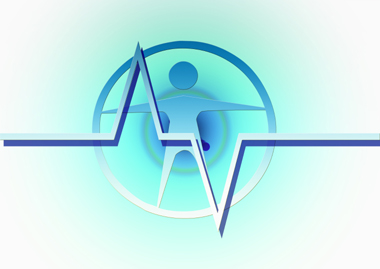 For all the reasons that we don’t burn out when we do tai chi, this old and sophisticated art offers solutions to people with a huge list of physical and emotional issues: memory disorders like Alzheimer’s Disease, muscle disorders, like Parkinson’s Disease, Anxiety Disorder, Chronic Organic Pulmonary Disease (COPD), Post-Traumatic Stress Disorder (PSD), Attention Deficit Hyperactivity Disorder (ADHD), cardiovascular disease, balance disorders, diabetes and more. And it’s a martial art that teaches self-protection, one-pointed focus, stress-free living and how to maximize health.
For all the reasons that we don’t burn out when we do tai chi, this old and sophisticated art offers solutions to people with a huge list of physical and emotional issues: memory disorders like Alzheimer’s Disease, muscle disorders, like Parkinson’s Disease, Anxiety Disorder, Chronic Organic Pulmonary Disease (COPD), Post-Traumatic Stress Disorder (PSD), Attention Deficit Hyperactivity Disorder (ADHD), cardiovascular disease, balance disorders, diabetes and more. And it’s a martial art that teaches self-protection, one-pointed focus, stress-free living and how to maximize health.
ACTION STEP
Consider doing tai chi. The training teaches you to move every part of you at a time. It’s always new because your movements change with understanding.
Go HERE to begin the inquiry process.
![]()
If you wish to share your story, please hit reply in your email program to be contacted.
![]()
FEEDBACK
We value your feedback very much.
Please leave a comment below.
Please LIKE us on the website and at
WarriorsOfWeight on Facebook.
You can also follow us on Twitter @warriorsoweight.
Thanks.
![]()
DIANE GOLD, PUBLISHER AND AUTHOR
Diane Gold, Founder of Warriors of Weight, Turning Habits Into Health, is a mentor in tai chi, kung fu and meditation, a music, fitness and stress expert, dedicated mom, studying plant-based nutrition and habit change.
She is excited to share some insight about workout burnout. She says,
“I have watched and experienced over and over the cycle of getting into a routine or habit and then, because of missing one instance of it, dissolving the routine for a new one. When we skip an activity or class once, we are beginning a new habit, that of feeling what it feels like to skip the activity and doing something else with that time. This starts the beginning fibers of a new routine which replaces going to the activity or class. When we skip the activity or class two times, it is sooooooo much easier to skip and put less importance in the third time and the fourth time. Pretty soon, the class is out of sight, out of mind; and we are on to the next routine.
“This is OK, as long as we know it is our choice and that is the right choice for us. If it is laziness, stop skipping, and get back to the original routine. And may the force be with you.”
![]()

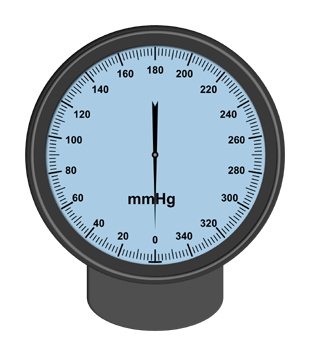 People with low vitamin D levels are more likely to die from cancer and heart disease and to suffer from other illnesses, scientists reported in two large studies published on Tuesday.
People with low vitamin D levels are more likely to die from cancer and heart disease and to suffer from other illnesses, scientists reported in two large studies published on Tuesday.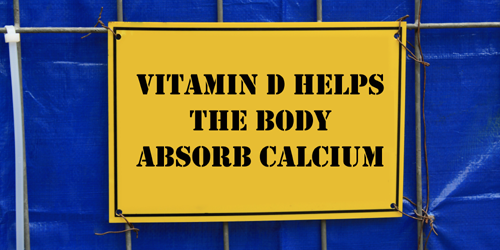 Vitamin D helps the body absorb calcium and is an important part of the immune system. Receptors for the vitamin and related enzymes are found throughout cells and tissues of the body, suggesting it may be vital to many physiological functions, said Dr. Oscar H. Franco, a professor of preventive medicine at Erasmus Medical Center in the Netherlands and an author of one of the new studies, which appeared in the journal BMJ [April 1, 2014.]*
Vitamin D helps the body absorb calcium and is an important part of the immune system. Receptors for the vitamin and related enzymes are found throughout cells and tissues of the body, suggesting it may be vital to many physiological functions, said Dr. Oscar H. Franco, a professor of preventive medicine at Erasmus Medical Center in the Netherlands and an author of one of the new studies, which appeared in the journal BMJ [April 1, 2014.]*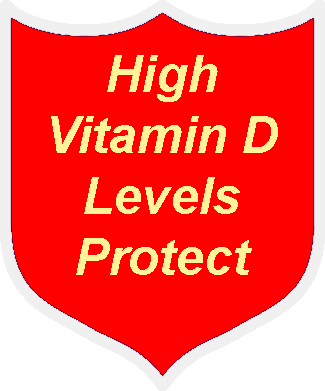 “Based on what we found, we cannot recommend widespread supplementation,” said Evropi Theodoratou, an author of the study and research fellow at the Center for Population Health Sciences at the University of Edinburgh. The second study also looked at bone health. While Vitamin D had long been believed to help prevent osteoporosis fractures from falls, clinical trials in recent years have challenged the idea. The study also found no evidence to support that assumption.
“Based on what we found, we cannot recommend widespread supplementation,” said Evropi Theodoratou, an author of the study and research fellow at the Center for Population Health Sciences at the University of Edinburgh. The second study also looked at bone health. While Vitamin D had long been believed to help prevent osteoporosis fractures from falls, clinical trials in recent years have challenged the idea. The study also found no evidence to support that assumption.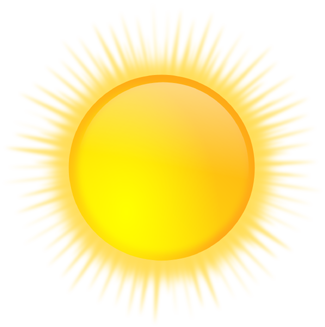 Dr. Theodoratou was not alone in suggesting people hold off on taking vitamin D supplements for now. Even though Dr. Franco found them to be beneficial, he said that more research was needed to show what levels are best. Instead of taking pills, people could improve their vitamin D levels with an adequate diet and 30 minutes of sunlight twice a week, he said.
Dr. Theodoratou was not alone in suggesting people hold off on taking vitamin D supplements for now. Even though Dr. Franco found them to be beneficial, he said that more research was needed to show what levels are best. Instead of taking pills, people could improve their vitamin D levels with an adequate diet and 30 minutes of sunlight twice a week, he said.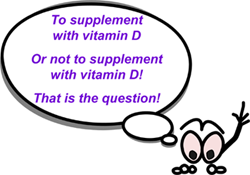 “But there is enough positive research currently to indicate that people should be supplementing with vitamin D for a variety of positive health outcomes,” he added.
“But there is enough positive research currently to indicate that people should be supplementing with vitamin D for a variety of positive health outcomes,” he added.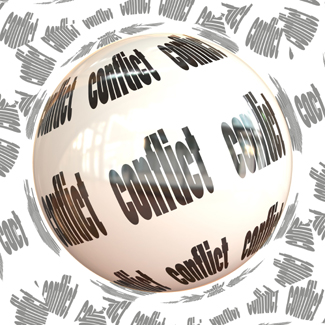 In all sectors that touch upon health care, there are conflicts of interest. We have the habit of ignoring them. In order to do research, we need money, so we sell products. These products may be less than perfect to save money and to make more. In order to live well, some of us may create partnerships and agree to job restrictions we never would have if we didn’t need the money. These are compromises. We all have made one. These are not unethical moves, in themselves. Ignoring the huge conflicts of interest that develop because of them is. Not making this disharmony common knowledge is!
In all sectors that touch upon health care, there are conflicts of interest. We have the habit of ignoring them. In order to do research, we need money, so we sell products. These products may be less than perfect to save money and to make more. In order to live well, some of us may create partnerships and agree to job restrictions we never would have if we didn’t need the money. These are compromises. We all have made one. These are not unethical moves, in themselves. Ignoring the huge conflicts of interest that develop because of them is. Not making this disharmony common knowledge is! Health insurance companies are another sector that creates conflicts of interest. The cost of insurance-reimbursable health care is so high that these companies foster the habit that they are the only way and that they are required. True, I would not want to be without health care as an almost 65-year-old citizen, but I do want to honor these comments from Jon Raymond, founder of Out In The Streets Films, from his article The Sadism Of American Health Care,
Health insurance companies are another sector that creates conflicts of interest. The cost of insurance-reimbursable health care is so high that these companies foster the habit that they are the only way and that they are required. True, I would not want to be without health care as an almost 65-year-old citizen, but I do want to honor these comments from Jon Raymond, founder of Out In The Streets Films, from his article The Sadism Of American Health Care,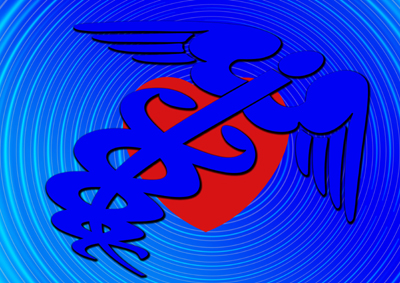 Our doctors may be promoting a drug or treatment protocol so that they receive a bonus or good connection from a drug company or an insurance company. Most doctors will not promote what they don’t believe in; however their discussion of drugs from a company that favors them they give their patients urges other doctors to do the same, benefiting the original prescriber and the drug company. If the drug could have been replaced with exercise or good food, this non-drug strategy gets lost in the shadows.
Our doctors may be promoting a drug or treatment protocol so that they receive a bonus or good connection from a drug company or an insurance company. Most doctors will not promote what they don’t believe in; however their discussion of drugs from a company that favors them they give their patients urges other doctors to do the same, benefiting the original prescriber and the drug company. If the drug could have been replaced with exercise or good food, this non-drug strategy gets lost in the shadows. We might also consider the ethics of raising animals for slaughter, or, in the case of dairy cows, shortening their lives by 80% as long as cows who do not get milked by machine on a dairy farm or traumatizing pigs in tiny cages.
We might also consider the ethics of raising animals for slaughter, or, in the case of dairy cows, shortening their lives by 80% as long as cows who do not get milked by machine on a dairy farm or traumatizing pigs in tiny cages.
 Finally, although there are conflicts in finance and natural resource manufacturing, too, we will close with media conflicts. Journalists have to omit some news. They report what their corporate heads allow, which often coincides with the voices of their advertisers.
Finally, although there are conflicts in finance and natural resource manufacturing, too, we will close with media conflicts. Journalists have to omit some news. They report what their corporate heads allow, which often coincides with the voices of their advertisers.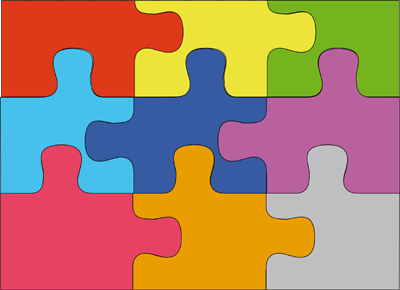 Know the conflicts of interest in health care, and eat well. Consider how funding drives decisions for all of us. Know that all our industries, factory farmers, health insurers, medical personnel and facilities, our research companies, government regulators are run by profit. And all the sectors fit together like a jigsaw puzzle.
Know the conflicts of interest in health care, and eat well. Consider how funding drives decisions for all of us. Know that all our industries, factory farmers, health insurers, medical personnel and facilities, our research companies, government regulators are run by profit. And all the sectors fit together like a jigsaw puzzle.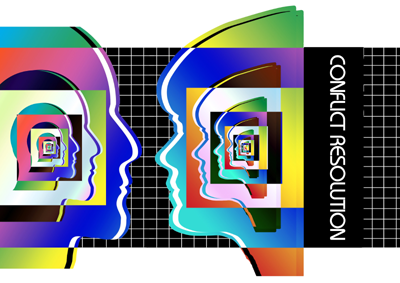
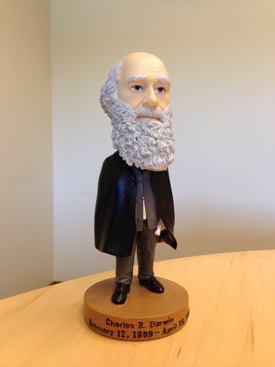 What makes the above quote a great definition is that Charles Darwin alludes to something similar in his Origin of the Species as did his predecessor, Jean-Baptiste Lamarck, 500 years before Darwin. They both arrived at the idea that traits can be passed down generationally even if they are acquired through acquired training of the previous generations. Another way of saying this would be that the offspring of parents who are trained in a certain behavior are born with the behavior and no previous training in the future generations.
What makes the above quote a great definition is that Charles Darwin alludes to something similar in his Origin of the Species as did his predecessor, Jean-Baptiste Lamarck, 500 years before Darwin. They both arrived at the idea that traits can be passed down generationally even if they are acquired through acquired training of the previous generations. Another way of saying this would be that the offspring of parents who are trained in a certain behavior are born with the behavior and no previous training in the future generations.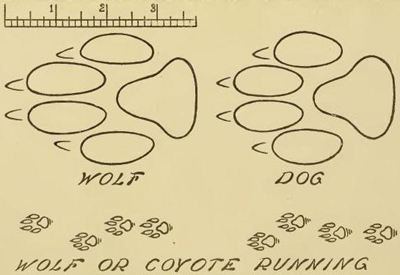 We can look at the domestication of one or two wolf species. The domesticated wolf became the dog, according to James Serpell, professor at University of Pennsylvania’s School of Vet Medicine in his 1995 The Domestic Dog. Through teaching the wolf pup of the wild wolf to be calm, gentle and social with humans; the offspring of the tamed wolf pups began to exhibit the gentler traits at birth, without any training.
We can look at the domestication of one or two wolf species. The domesticated wolf became the dog, according to James Serpell, professor at University of Pennsylvania’s School of Vet Medicine in his 1995 The Domestic Dog. Through teaching the wolf pup of the wild wolf to be calm, gentle and social with humans; the offspring of the tamed wolf pups began to exhibit the gentler traits at birth, without any training.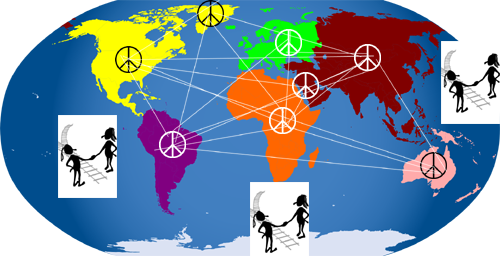 So, the way of our evolution has to do with the training we are given which, if ingrained in us well, can be passed down to our offspring or to their future generations from birth. What could exist is our own domestication, cultivating the habit of peaceful coexistence.
So, the way of our evolution has to do with the training we are given which, if ingrained in us well, can be passed down to our offspring or to their future generations from birth. What could exist is our own domestication, cultivating the habit of peaceful coexistence.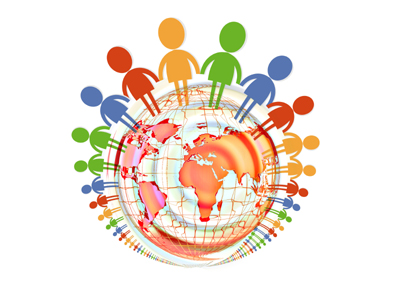 The point here is if we start role playing peaceful solutions to different circumstances when we are young, we will be very experienced at conflict resolution by the time we reach 25 when our voices can help run the world. We will recognize human rights violations and know how to use our voices against them using our peaceful methods. This means we may be interested in letting go of our old ways.
The point here is if we start role playing peaceful solutions to different circumstances when we are young, we will be very experienced at conflict resolution by the time we reach 25 when our voices can help run the world. We will recognize human rights violations and know how to use our voices against them using our peaceful methods. This means we may be interested in letting go of our old ways.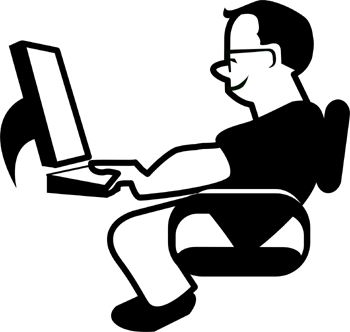 Think about what happens when we have unwanted mucous in our body. We have difficulty breathing. This is because our airway is blocked.
Think about what happens when we have unwanted mucous in our body. We have difficulty breathing. This is because our airway is blocked.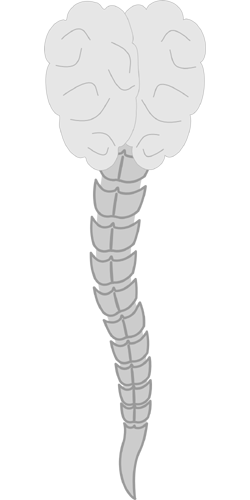 When we keep slouching, we get used to it and it becomes normal. Unless we take a good long look, there are probably 5 times a day we slouch without noticing it: tidying up, cooking, working, driving, sitting on the toilet are some examples. We know that we develop a habit from a cue. The cue is the urge to relax or the urge to rest. What could possibly be wrong with letting the shoulders go while we are cooking? Isn’t this activity supposed to be mellow and fun?
When we keep slouching, we get used to it and it becomes normal. Unless we take a good long look, there are probably 5 times a day we slouch without noticing it: tidying up, cooking, working, driving, sitting on the toilet are some examples. We know that we develop a habit from a cue. The cue is the urge to relax or the urge to rest. What could possibly be wrong with letting the shoulders go while we are cooking? Isn’t this activity supposed to be mellow and fun?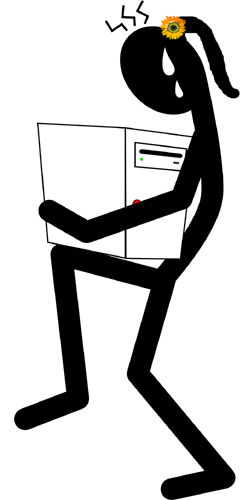 When we look at daily activities that require us to carry weight, we have to use our legs to take the pressure off our backs and our knees. Take vacuuming, sweeping, carrying out the recycling bin. These tasks require us to exert effort. When we bend the knees to engage the legs, we can do the pushing, pulling, carrying without compromising our spine. When an object is fairly bulky or awkward, it’s important to use some type of leverage (bent knees, a wagon, a dolly or a partner to avoid slouching the back during this enterprise.
When we look at daily activities that require us to carry weight, we have to use our legs to take the pressure off our backs and our knees. Take vacuuming, sweeping, carrying out the recycling bin. These tasks require us to exert effort. When we bend the knees to engage the legs, we can do the pushing, pulling, carrying without compromising our spine. When an object is fairly bulky or awkward, it’s important to use some type of leverage (bent knees, a wagon, a dolly or a partner to avoid slouching the back during this enterprise.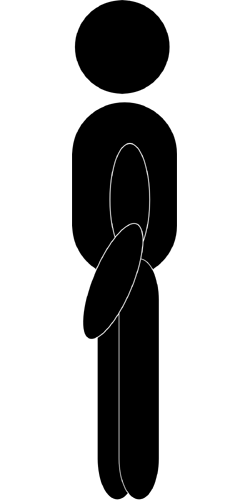 Funny as it may sound, using the abdominal plate to hold the back erect is the easiest way to insure a healthy posture. This would mean this set of muscles has to be strong enough to endure the weight of the undertaking.
Funny as it may sound, using the abdominal plate to hold the back erect is the easiest way to insure a healthy posture. This would mean this set of muscles has to be strong enough to endure the weight of the undertaking.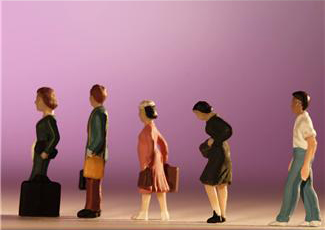 Large-chested women will find this particularly helpful as they have the challenge of not leaning too far back or forward to compensate for the weight of the chest.
Large-chested women will find this particularly helpful as they have the challenge of not leaning too far back or forward to compensate for the weight of the chest.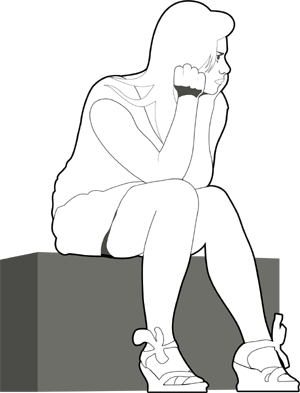 Slouching is insidious. It pops into our lives when we least expect and becomes normal unless we manage and fix it. When we are younger, it doesn’t seem like a big deal, except that the earlier on we make our move, the earlier we will develop the habit of an aligned body.
Slouching is insidious. It pops into our lives when we least expect and becomes normal unless we manage and fix it. When we are younger, it doesn’t seem like a big deal, except that the earlier on we make our move, the earlier we will develop the habit of an aligned body.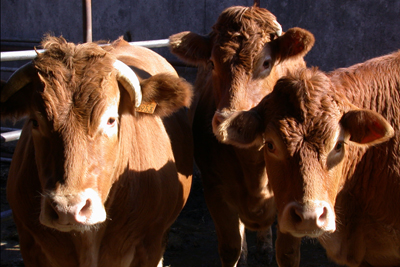 The habit of eating meat is passed down from one generation to another, in most societies. Throughout the years, a symbol of abundance has become the finest steak dinner, so much so that, at one point, the overproduction of uric acid crystals between the joints known as gout, got the nickname “disease of the rich” because wealth often meant increased intake of animal proteins.
The habit of eating meat is passed down from one generation to another, in most societies. Throughout the years, a symbol of abundance has become the finest steak dinner, so much so that, at one point, the overproduction of uric acid crystals between the joints known as gout, got the nickname “disease of the rich” because wealth often meant increased intake of animal proteins.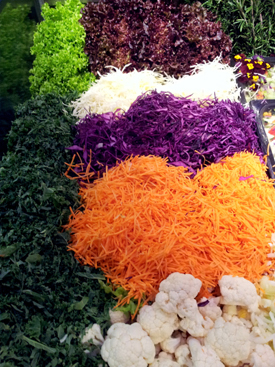 What is now becoming common knowledge, or is such to the Millenial generation and after, is that hunger and thirst could be contained if we increased our plant-based nutrition consumption; we could reduce many chronic diseases if we reduced or removed meat from our diet; our water footprint to farm livestock for food is sending the world economies on a downward spiral of water emergencies; especially in the latest generation, people are questioning whether it is ethical to eat meat (which could includes but is not limited to beef, pork, lamb, chicken, fish, bees).
What is now becoming common knowledge, or is such to the Millenial generation and after, is that hunger and thirst could be contained if we increased our plant-based nutrition consumption; we could reduce many chronic diseases if we reduced or removed meat from our diet; our water footprint to farm livestock for food is sending the world economies on a downward spiral of water emergencies; especially in the latest generation, people are questioning whether it is ethical to eat meat (which could includes but is not limited to beef, pork, lamb, chicken, fish, bees). 3)
3)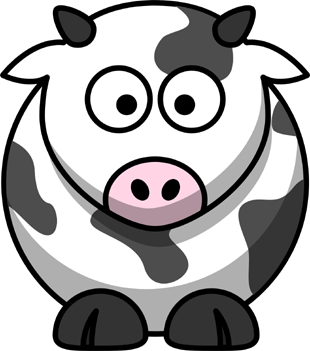 For those not calculating, if antibiotics are used in animal feed, the drug companies get paid for their drugs and farmers get to fatten up their livestock more quickly from the antibiotics so they reduce feeding expense. This translates to a less healthy environment, chemically altered food and reduced health.
For those not calculating, if antibiotics are used in animal feed, the drug companies get paid for their drugs and farmers get to fatten up their livestock more quickly from the antibiotics so they reduce feeding expense. This translates to a less healthy environment, chemically altered food and reduced health.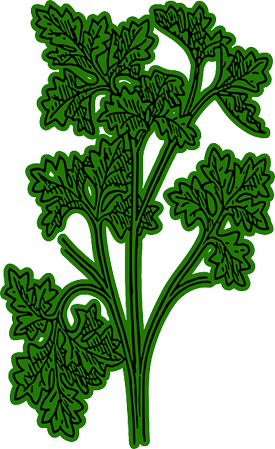
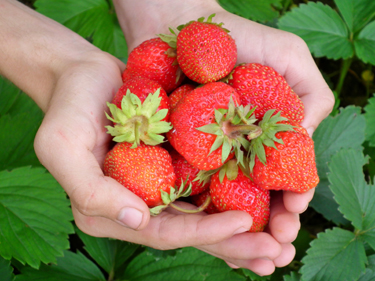 Instead of blindly consuming food, just because it tastes good to us, we might want to consider the consequences of our actions. Not following in the footsteps of the past generations, we might want to evaluate the newest scientific evidence about food and nutrition. We might choose to realize that the dairy and meet industries have vast sums of money to promote the idea of eating meat or consuming dairy. Big media are friends with big dairy, big meat, big poultry and big pharma. These relationships may be cause for us to do our own research on whether the habit of eating meat needs a complete turnaround in 2014.
Instead of blindly consuming food, just because it tastes good to us, we might want to consider the consequences of our actions. Not following in the footsteps of the past generations, we might want to evaluate the newest scientific evidence about food and nutrition. We might choose to realize that the dairy and meet industries have vast sums of money to promote the idea of eating meat or consuming dairy. Big media are friends with big dairy, big meat, big poultry and big pharma. These relationships may be cause for us to do our own research on whether the habit of eating meat needs a complete turnaround in 2014.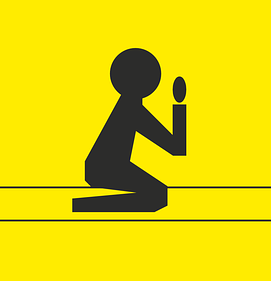 3)
3)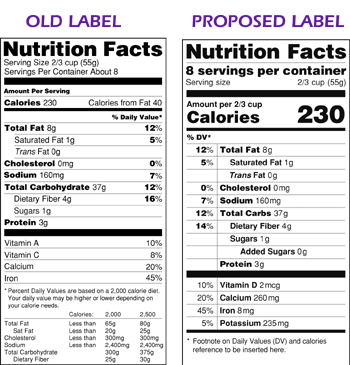 Food labels, the next generation in nutritional data, is being proposed by the Food And Drug Administration. The changes to the nutritional label would help consumers identify food facts more easily, get a more realistic and up-to-date version of what a portion of food in the present day represents and know what sugars in a product are added and not part of the inherent make-up of the food.
Food labels, the next generation in nutritional data, is being proposed by the Food And Drug Administration. The changes to the nutritional label would help consumers identify food facts more easily, get a more realistic and up-to-date version of what a portion of food in the present day represents and know what sugars in a product are added and not part of the inherent make-up of the food.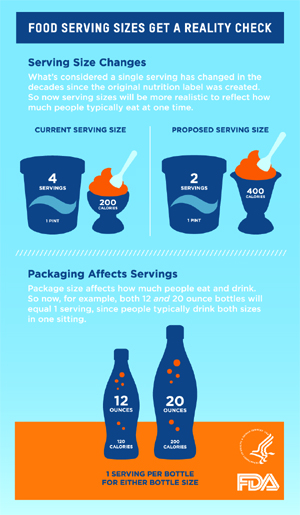 What we used to eat 20 years ago that was listed by FDA as one serving is being recognized as obsolete and totally inaccurate. Due to our larger servings or mislabeling originally, the portion size on the label is being increased. So, if we ate ice cream before the label changes, 1 serving would be 200 calories, half a cup, with 4 servings in the pint.
What we used to eat 20 years ago that was listed by FDA as one serving is being recognized as obsolete and totally inaccurate. Due to our larger servings or mislabeling originally, the portion size on the label is being increased. So, if we ate ice cream before the label changes, 1 serving would be 200 calories, half a cup, with 4 servings in the pint.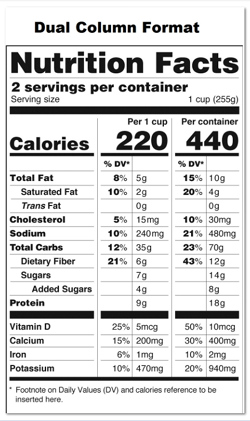 The term cup is helpful because it’s something we can measure. The term container keeps is nebulous since containers range in sizes.
The term cup is helpful because it’s something we can measure. The term container keeps is nebulous since containers range in sizes.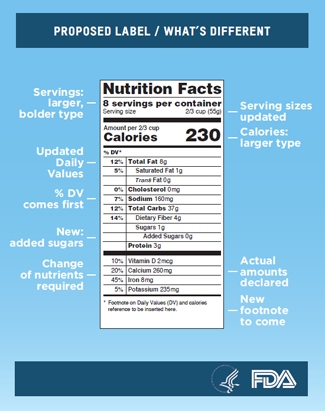
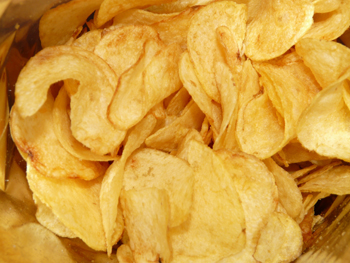 Eating an entire bag of chips, on my part, is possible. It’s similar to my addictive ways with any substance. If I indulge in it once, I will want to indulge again the next day and will have to put forth a concerted effort to replace the potato chip buying behavior with another for, at least, a month, until, if I am lucky, the urge will go dormant again. When I do it, I usually buy baked (reducing the fat grams to 24 greasy grams), since fried will make me feel sick and the craving for grease will require more will power to replace.
Eating an entire bag of chips, on my part, is possible. It’s similar to my addictive ways with any substance. If I indulge in it once, I will want to indulge again the next day and will have to put forth a concerted effort to replace the potato chip buying behavior with another for, at least, a month, until, if I am lucky, the urge will go dormant again. When I do it, I usually buy baked (reducing the fat grams to 24 greasy grams), since fried will make me feel sick and the craving for grease will require more will power to replace.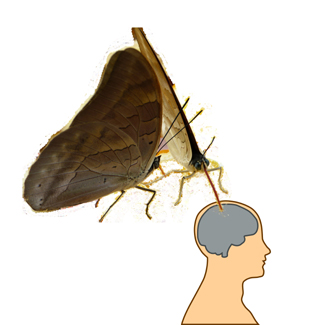
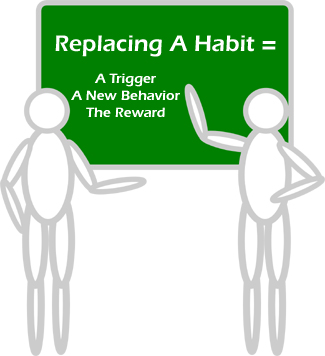 So, here’s this task we have for ourselves. We have a habit, and we want to replace it.
So, here’s this task we have for ourselves. We have a habit, and we want to replace it.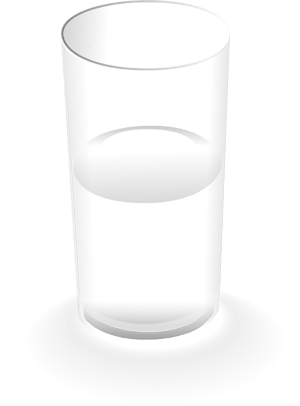 Consider the glass’ being half empty or half full concept. When the glass is full, we think of richness. The empty term, in Western terms, can speak to barrenness, although, in the Eastern way, emptiness is the way to abundance.
Consider the glass’ being half empty or half full concept. When the glass is full, we think of richness. The empty term, in Western terms, can speak to barrenness, although, in the Eastern way, emptiness is the way to abundance.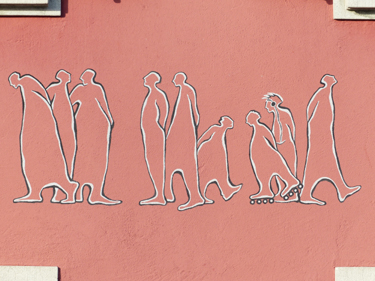 Be careful of the feeling of boredom. It can act as a built-in excuse for doing a certain behavior that is not good for us. We might think that if we had excitement rather than stagnation in our lives, we would not act out the behavior we wanted to change. We might even create the boredom to delude ourselves.
Be careful of the feeling of boredom. It can act as a built-in excuse for doing a certain behavior that is not good for us. We might think that if we had excitement rather than stagnation in our lives, we would not act out the behavior we wanted to change. We might even create the boredom to delude ourselves.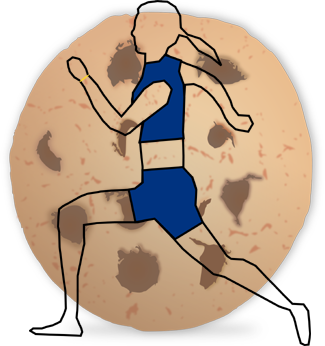 Let’s say we always get the urge to eat dessert. We can change our reaction to this trigger by planning another behavior in its stead, such as going jogging as soon as that urge is felt. This will begin the process of replacement. Repeating this behavior will turn it into a habit. By behaving consistently by jogging and not dessert eating, we will have replaced our old with the new behavior. Although this certainly is quitting acting out the old behavior from the sheer repetition of the act; it’s easier to accomplish by using the concept of “replace.”
Let’s say we always get the urge to eat dessert. We can change our reaction to this trigger by planning another behavior in its stead, such as going jogging as soon as that urge is felt. This will begin the process of replacement. Repeating this behavior will turn it into a habit. By behaving consistently by jogging and not dessert eating, we will have replaced our old with the new behavior. Although this certainly is quitting acting out the old behavior from the sheer repetition of the act; it’s easier to accomplish by using the concept of “replace.”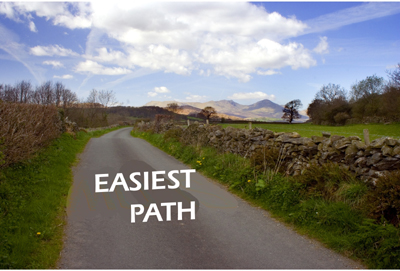 Of course, when we want to do something new in place of some old habit, we want to give ourselves the easiest path to follow. That path involves planning one simple action that will be repeated over and over again. It also requires saying “replace” instead of “quit.”
Of course, when we want to do something new in place of some old habit, we want to give ourselves the easiest path to follow. That path involves planning one simple action that will be repeated over and over again. It also requires saying “replace” instead of “quit.”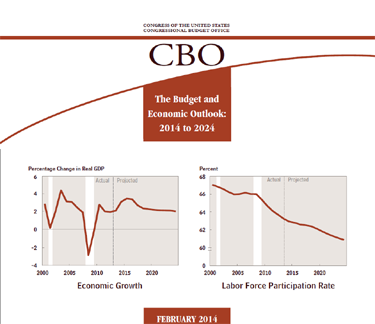 The Health Care Law Is Projected To Shrink The Work Force. This headline looks at full-time workers in an estimate from the Congressional Budget Office. According to Jason Furman, Council Of Economic Advisors Chairman, the change in number of workers has to do more with people’s choosing part-time assignments rather than that employers are deleting jobs to avoid employee’s health insurance costs.
The Health Care Law Is Projected To Shrink The Work Force. This headline looks at full-time workers in an estimate from the Congressional Budget Office. According to Jason Furman, Council Of Economic Advisors Chairman, the change in number of workers has to do more with people’s choosing part-time assignments rather than that employers are deleting jobs to avoid employee’s health insurance costs.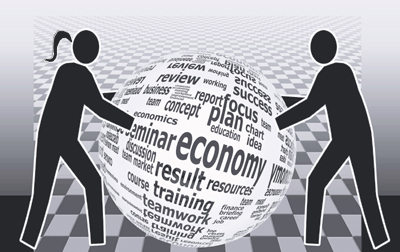 Certainly, we are bound to contribute to humanity in a way that sustains us in some financial way and in order to leave a personal human legacy. We don’t have to get it by having a J-O-B in an environment, where group health care was the only reason we took the job. We can be CRE-8-TIVE and do what we love, which, for most people, is not what they do at their J-O-B. They can be small business owners, putting them in a category to be able to pay for themselves, but out of the headlined category: full-time W-2 worker, about whom the CBO is estimating.
Certainly, we are bound to contribute to humanity in a way that sustains us in some financial way and in order to leave a personal human legacy. We don’t have to get it by having a J-O-B in an environment, where group health care was the only reason we took the job. We can be CRE-8-TIVE and do what we love, which, for most people, is not what they do at their J-O-B. They can be small business owners, putting them in a category to be able to pay for themselves, but out of the headlined category: full-time W-2 worker, about whom the CBO is estimating. There is so much creative energy that we all possess that is channeled by some into entrepreneurship. The people in this division make some of the breakthroughs that make our country great and make us happy Americans. We are thriving spiritually because of choices like entrepreneurship. Yes, there are just as many, if not more people who have that same spark of invention who don’t make a living at it and struggle. But they deserve the time to keep working at it.
There is so much creative energy that we all possess that is channeled by some into entrepreneurship. The people in this division make some of the breakthroughs that make our country great and make us happy Americans. We are thriving spiritually because of choices like entrepreneurship. Yes, there are just as many, if not more people who have that same spark of invention who don’t make a living at it and struggle. But they deserve the time to keep working at it. It’s fair to say that what keeps us happy and healthy is our own personal foundation. When we have a belief system or a set of ethics by which we live; this drives us to do act the way we do and make the decisions that we do.
It’s fair to say that what keeps us happy and healthy is our own personal foundation. When we have a belief system or a set of ethics by which we live; this drives us to do act the way we do and make the decisions that we do.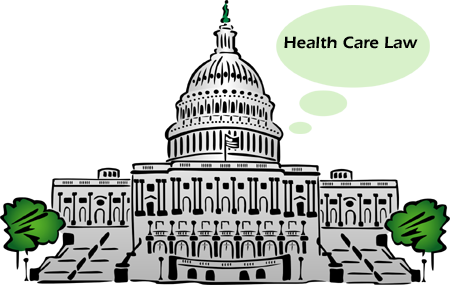 The Health Care Law aka The Affordable Care Act aka Obamacare is part of the legacy of Barack Obama, 44th President of the United States. It allows for people previously uninsurable due to health issues to be insurable. It allows for people who could not afford health insurance to be subsidized enough to get it.
The Health Care Law aka The Affordable Care Act aka Obamacare is part of the legacy of Barack Obama, 44th President of the United States. It allows for people previously uninsurable due to health issues to be insurable. It allows for people who could not afford health insurance to be subsidized enough to get it.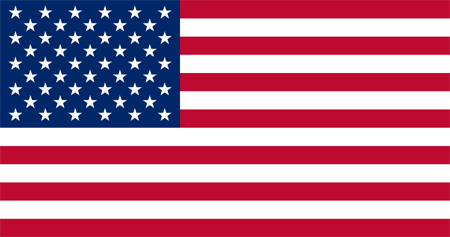 Finally, it seems as if freedom of choice is the reason for the shrinking employee headline. We’re all different. There’s no one way to be. And, through the ACA, the United States has just happily extended our freedom.
Finally, it seems as if freedom of choice is the reason for the shrinking employee headline. We’re all different. There’s no one way to be. And, through the ACA, the United States has just happily extended our freedom.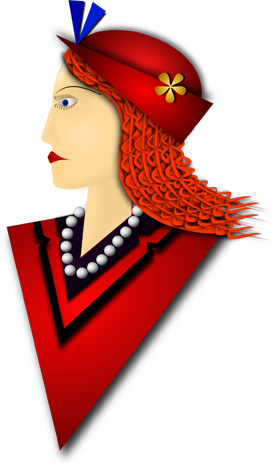 We develop habits based on how certain actions make us feel. Whether we wear designer clothes, keep our hair immaculate or stay fit because we enjoy people’s staring at us; we act out behaviors regularly to achieve these good feelings, aka rewards. The cue, which is the original feeling that makes us do a behavior urges us to work so we have access to buy clothing, get our hair done, so we look how we like. This urge also pushes us to work out so that our bodies look good, which gives us the end result: the reward of having people acknowledge our beauty. Appearance
We develop habits based on how certain actions make us feel. Whether we wear designer clothes, keep our hair immaculate or stay fit because we enjoy people’s staring at us; we act out behaviors regularly to achieve these good feelings, aka rewards. The cue, which is the original feeling that makes us do a behavior urges us to work so we have access to buy clothing, get our hair done, so we look how we like. This urge also pushes us to work out so that our bodies look good, which gives us the end result: the reward of having people acknowledge our beauty. Appearance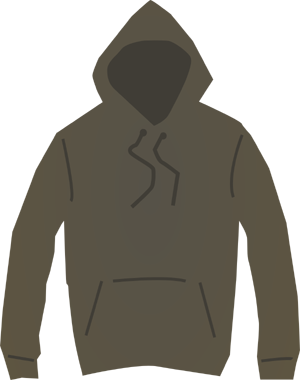 These are only examples of appearance habits we may have. There are others of us who specifically wear clothing to make us invisible, since we don’t like it when people stare. And there are others of us who do not consider what people think; they are busy with their own lives and work.
These are only examples of appearance habits we may have. There are others of us who specifically wear clothing to make us invisible, since we don’t like it when people stare. And there are others of us who do not consider what people think; they are busy with their own lives and work.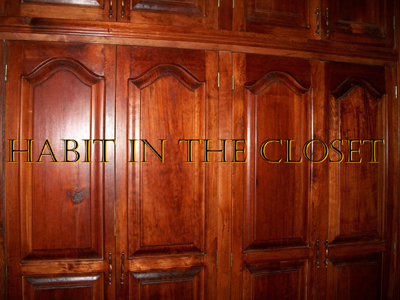 When we choose to change one of our habits, we replace the habit that was there with a new one. The old one is still there, but it is a “habit in the closet,” so to speak. As long as we are doing a new behavior and not opening the closet, the habit will stay put. For as long as we choose. Habit In The Closet
When we choose to change one of our habits, we replace the habit that was there with a new one. The old one is still there, but it is a “habit in the closet,” so to speak. As long as we are doing a new behavior and not opening the closet, the habit will stay put. For as long as we choose. Habit In The Closet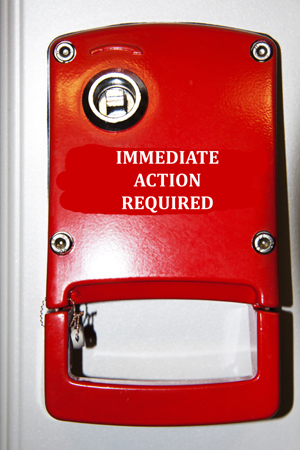
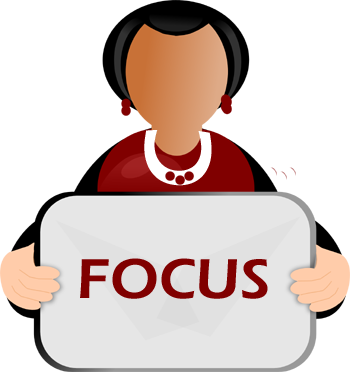
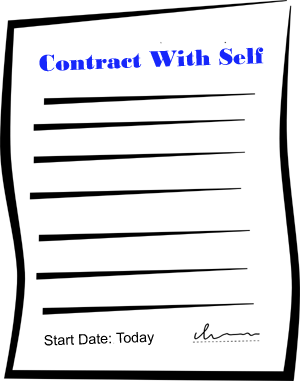 1)
1)